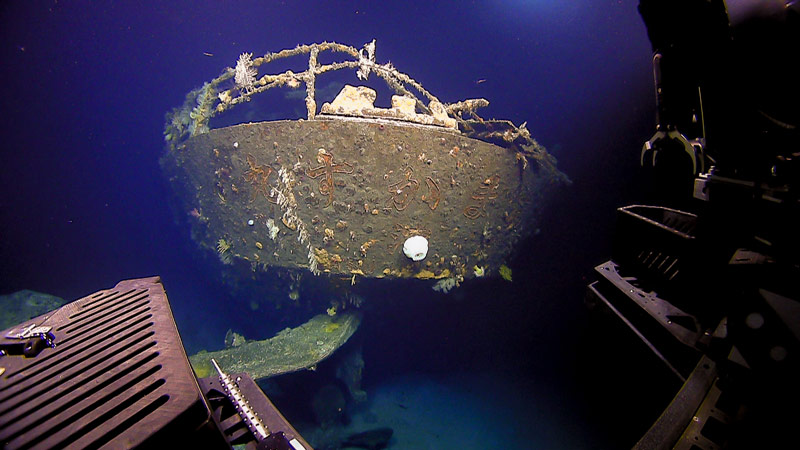
The stern of the Amakasu Maru No. 1 with her name still visible 73 years after she was sunk. Image courtesy of the NOAA Office of Ocean Exploration and Research, Deepwater Wonders of Wake. Download larger version (jpg, 1.1 MB).

The stern of the Amakasu Maru No. 1 with her name still visible 73 years after she was sunk. Image courtesy of the NOAA Office of Ocean Exploration and Research, Deepwater Wonders of Wake. Download larger version (jpg, 1.1 MB).
Dive 9: Amakasu Maru WWII Shipwreck
On August 11, we set out to explore a potential shipwreck target that had been mapped during a previous Okeanos Explorer cruise. Scientists believed that the wreck might be the Japanese Imperial Naval Destroyer, Hayate, which was sunk during the Battle of Wake.
The remotely operated vehicles landed close to the target and quickly came upon the bow of a ship. After exploration to determine the ship's identity, it became apparent that the wreck was not that of the Hayate. Once the vehicles made their way to the stern of the vessel, scientists were surprised to see lettering still visible on the hull. One of the participating biologists, Asako Matsumoto, was able to translate the name of the ship for us and we determined that the ship was the Amakasu Maru No. 1, which was a Japanese water tanker that was sunk by a U.S. submarine in 1942. Video courtesy of the NOAA Office of Ocean Exploration and Research, Deepwater Wonders of Wake. Download larger version (mp4, 246.3 MB).
Today we set off in search of the Japanese Imperial Naval Destroyer, Hayate, which was sunk during the Battle of Wake. A previous mapping cruise on board the Okeanos Explorer had identified a very promising target that looked like a shipwreck and was about the right size to be the Hayate. We landed the vehicles about 100 meters away from the sonar target so we could make a very cautious approach to the wreck. Immediately, we started to see ship debris in the sediment and we had a very strong sonar target in the Seirios scanning sonar. The remotely operated vehicle (ROV) came up on the bow of the ship, right were we expected the wreck to be. There was a lot of excitement on the ship. Then we set about trying to confirm the ship identity. Very quickly, we all started to have doubts that this was in fact the Hayate. As we all compared the diagrams of the Hayate to what we were seeing, we became more and more convinced that we had found a yet-to-be-identified ship. Once we made our way to the stern of the vessel, we were surprised to see lettering still visible on the hull. One of our participating biologists, Asako Matsumoto, was able to translate the name of the ship for us and a Google search reveled the ship to be the Amakasu Maru No. 1, which was a Japanese water tanker that was sunk by a U.S. submarine in 1942. We spent another hour documenting the wreck, then we moved on to two more sonar targets that we thought could be the Hayate. However, both targets turned out to be rocks, so the final resting place of the Hayate will continue to be a mystery for a bit longer. Once we recovered the ROVs, we started mapping for the night.